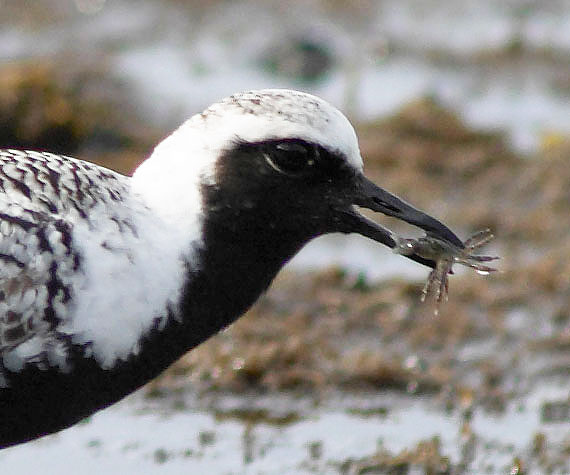Shorebird Sanctuary
Highlighting the Beauty of the Flora and Fauna of our Wetlands

The Shorebird Sanctuary exhibit is a home for birds, fishes, and native plants. Designed to resemble a wetland such as the Bolsa Chica State Marine Conservation Area, the exhibit features several microecosystems and shelters four species of shorebirds plus a diving duck.
Black-necked Stilts, Black-bellied Plovers, Western Snowy Plovers, a Killdeer, and Ruddy Ducks provide opportunities to observe and learn about these usually migratory birds, some of which liked the California climate so well that they became residents.
A coastal wetland is characterized by soil that is saturated by saltwater or a mix of fresh and saltwater (brackish) as a result of tidal flow and fresh water runoff. These areas support a wide range of plants and animals. The Shorebird Sanctuary exhibit has a mudflat that is typical of a Southern California wetland. Much like a tidepool has different zones, a tidal mudflat has very different characteristics in the high, middle, and low zones of the marsh. Each zone is typified by vegetation such as saltgrass that may just get its roots wet or eelgrass that is often totally submerged. These plants have adapted to the salt level of their habitat in different ways. Some exclude salt while others accumulate or excrete it.
There are about twenty plant species native to Southern California wetlands, but only a few that can tolerate the heavy salt-laden soil at the lowest elevations. One of these is sea-blite, Suaeda esteroa.
Estuary sea-blite, a 3-12 inch high salt tolerant plant, has button-like diminutive green flowers. It is the favorite host plant of the western pygmy blue butterfly (Brephidium exile). Only 3/8 inches wide, this tiny animal is one of the world’s smallest butterflies. The adult butterfly lays its blue-green eggs on the leaves of the plant. The caterpillars eat the leaves, flowers, and fruit while adults dine on the nectar of the flowers. Perhaps our Shorebird Sanctuary will attract and serve as a home for this local species.
It is estimated that California has lost more than 95 percent of its wetlands—more than any other state. With only 13,000 acres of wetlands remaining in Southern California, wintering sites for migratory birds traveling the Pacific Flyway have declined markedly. It is our hope that our Shorebird Sanctuary will both bring awareness about this issue that results in stewardship, and also highlight the beauty of the flora and fauna of our wetlands.

Photo taken in Alaska during breeding season. Credit: Matt Goff (www.narwhal.org)
Black-bellied Plovers (Pluvialis squatarola) are named for the all-black belly adults have. The plumage of immature birds is shades of brown. These birds, the largest of all North American Plovers, are a medium-sized shorebird almost 10 inches in length. They make impressive migrations, flying all the way from their breeding habitats in the Arctic tundra on Alaska islands and the northwestern coasts of Canada and Alaska to the east and west coasts of the U.S, Mexico, and Central America.

Black-necked Stilts (Himantopus mexicanus) have a long dark bill and tall, and skinny, pink legs. The only bird with longer legs in proportion to body size is the flamingo. Measuring 13-16 inches in length, this shorebird has a black capped head and wings with a white neck and belly, and a white spot above each of its dark eyes. Living as long as 20 years old, these birds are found in salt marshes along the Pacific and Atlantic coasts and the Gulf of Mexico as well as inland in Idaho, Kansas, and the Rocky Mountains. Resident groups call some Southern California wetlands home.

Killdeer near water searching for a meal. Credit: ©Tom Grey
Killdeer (Charadrius vociferous) get their name from the noise these birds make when alarmed—a distinct kill-deer cry. Their scientific species name, vociferous, is Latin for noisy. This species makes use of both saltwater and freshwater habitats, often far from the coast but always near water. Unlike most shorebirds, they often live close to humans in golf courses, parks, lawns, and even graveled parking lots. Males and females look alike. The upper back and most of the head is brownish. White patches mark the eyes, chin, and belly. Adults have two black bars across the breast while juveniles have only one stripe. Tail feathers usually have a black border and are often orange-tan in color. Their slender legs are pink or flesh-colored and they have a black bill.

Photo taken at Two Cities NWR Credit: Courtesy of USFWS
Ruddy Ducks, (Oxyura jamaicensis), are stifftailed diving ducks. They are often seen holding their tails straight up in the air. In the winter both males and females are similar in appearance but in the summer breeding season, males are easily identified. The male’s gray bill changes to a blue-gray and the plumage on his chest, rump, and flanks becomes a red-brown or cinnamon color. Females have a subdued brownish coloring. Ruddy Ducks walk very awkwardly on land because of the far back placement of their legs. They prefer to escape danger by diving deep and swimming away from it instead of taking to the air.

Nesting Western Snowy Plover Credit: Courtesy of USGS
Western Snowy Plovers (Charadrius alexandrinus nivosus) are a light buff color that allows them to camouflage in sandy habitats. In addition they turn away from a predator to hide their darker plumage. About the size of a sparrow, the Pacific coast population of this subspecies is listed as threatened to extinction by both the state and federal governments. There are resident populations in California and the Aquarium may form a partnership with the University of California, Santa Barbara’s Coal Oil Point Preserve where the university has a snowy plover restoration project. Volunteers watch out for the plovers and their nests, and educate beachgoers about sharing the beach with these tiny birds. Fencing of nesting sites helps keep unleashed dogs and predators at bay.
